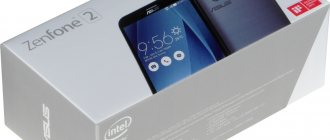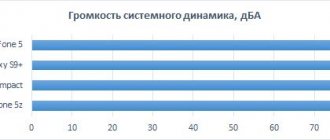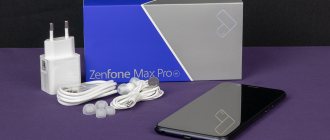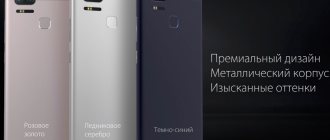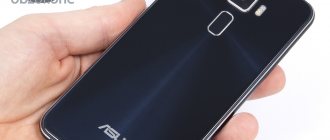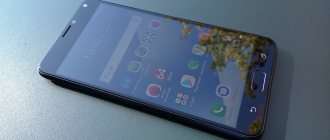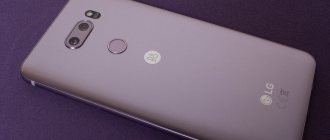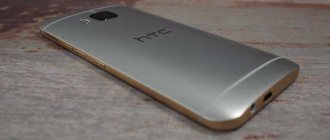To increase the screen area last year, manufacturers massively resorted to using all kinds of cutouts for the selfie camera, and in 2020 the market was swept by a new trend - the implementation of the front camera in the form of a separate mechanism hidden inside the body. Asus went the furthest, and in ZenFone 6 it completely abandoned the front module, offering a multifunctional main camera as an alternative. Our review of Asus ZenFone 6 will tell you whether such a solution is practical, as well as all the advantages and disadvantages of the flagship.
Characteristics of Asus ZenFone 6 (2019):
- Screen: 6.4″, IPS, FHD+ (2340×1080), HDR10, 19.5:9, 403 ppi, Gorilla Glass 6;
- Processor: Snapdragon 855 (8×1.8-2.84 GHz, 7 nm), Adreno 640 graphics;
- Permanent memory: 64/128/256 GB (UFS 2.1) + MicroSD up to 1 TB;
- RAM: 6/8 GB (LPDDR4X);
- Camera: 48 MP (Sony IMX586, f/1.8, 1/2", 0.8 micron, EGF 26 mm) + 13 MP (f/2.4, EGF 11 mm), laser autofocus, 4K/60fps video recording;
- Battery: 5000 mAh, fast charging 18 W;
- SIM: x2 Nano-SIM;
- Wireless communications: 4G, Bluetooth 5.0 (aptX HD), Wi-Fi dual-band 802.11ac, dual GPS, NFC;
- Ports: Type-C (USB 2.0, OTG).
- Additionally: Face Unlock, stereo speakers, 3.5 mm jack, Hi-Res Audio 192/24;
- OS: Android 9 Pie + ZenUI 6;
- Dimensions: 159.1 x 75.4 x 9.2 mm, weight - 190 g.
- Color: Midnight Black, Twilight Silver.
Pre-order for ZenFone 6 started on May 23 and the first batch of smartphones was booked by lunchtime of the same day. The exact release date of the smartphone is not known, but according to our information, the full start of sales will take place in early June. The official price of ZenFone 6 in Russia is 42,990 rubles for the version with 128/6 GB of memory.
Design and usability
At the presentation of ZenFone 6, the developers focused on the fact that its 6.4-inch diagonal is a reference solution in terms of dimensions; they say that this is the size of the smartphone that most users called the most convenient. I can confirm that the phone really feels comfortable in the hand, despite its solid weight of 190 grams and considerable thickness - 9.2 mm. The latter is explained by a capacious 5000 mAh battery inside the case.
The back cover is made from Gorilla Glass 6 and is slightly curved at the edges, making the phone feel thinner than it actually is. The main feature of the new Zenfon is a rotating block of two chambers, made of a special alloy “Liquid Metal”. The camera array is quite large; it is driven by a special motor, the working life of which ASUS estimates at 100 thousand operations. We heard figures from Chinese manufacturers that are 2-3 times higher, but even this is enough for 5 years of phone operation when using the front camera 30 times a day.
The rotating camera itself is implemented very thoughtfully: it automatically hides when the phone falls, in addition, the mechanism can be closed manually without consequences. When opened, the camera can be fixed in intermediate positions, which can be used during video communication or to create interesting effects when shooting video. The block itself protrudes minimally beyond the body and does not interfere with using the phone lying on the table. No flaws were found in its operation during testing of the device. I’ll just note that if you tap on the camera, it rattles a little, and with sharp movements of the phone it can open spontaneously, so there are concerns about whether the mechanism will become loose during use of the smartphone.
The abandonment of the front camera made it possible to implement a completely frameless screen without any cutouts. The display occupies 92% of the front panel of the phone, the frames on the top and sides are symmetrical, but there is a small chin at the bottom. The glass on the screen is only slightly rounded at the edges, opponents of curved screens can calmly exhale - the percentage of false clicks when using the phone is near zero. ZenFone 6 also has an LED notification indicator, which is located above the screen, to the right of the thin earpiece grille.
In addition to the rotating camera, ZenFone 6 has another feature - a separate button for calling Google Assistant, which can be reassigned to perform almost any task with a single or double press. It’s just that you have to reach for the multifunction key, since it is located very high, above the power button and the volume rocker on the right side of the device.
On the left there is a triple card tray, capable of accepting 2 NanoSIM and a MicroSD memory card at once - thanks to ASUS for this, since most current flagships do not have the ability to expand memory at all.
On the bottom you will find a Type-C port, a microphone hole, a speaker and a 3.5mm jack. ZenFone 6 is not waterproof, which is expected given the complexity of the PTZ camera design. But the fact that there is no place for wireless charging inside the case is frustrating. ASUS justifies the decision to abandon this feature due to the negative impact of wireless charging on battery life.
Design
Asus' pursuit of the advanced end phone user began with the choice of screen size, or more precisely, screen width. So the Zenfone 6 has a 6.4-inch 19.5:9 display - it provides plenty of screen without being too bulky.
We can confirm that the phone is comfortable to hold despite its hefty 190g weight. Which brings us to another feature on the priority list, and that's battery life - the Zenfone's weight is easily explained by the 5,000mAh battery inside. Asus has opted for a curved back cover, which helps the phone feel thinner than it is.
However, there wasn't enough space for wireless charging or ultra-fast charging technology. Asus says that both inductive charging and 27-30W fast charging have a negative impact on battery life in the long run.
Whether they justify these trade-offs or not, the end result is Qualcomm QuickCharge 4.0. And it's good that Asus also includes such an adapter in the box. In 30 minutes we got 35% charge, which is quite decent considering the capacity of the monster.
You'll probably notice the fingerprint scanner on the back - it's a conventional solution rather than the fancy touchscreen display of the time. You see, they only work with OLED displays, and an OLED display would drive the price down to something they didn't want.
The Zenfone 6's 6.4-inch screen is an IPS LCD with a resolution of 1080x2340px, so nothing special. From our initial experience, this is a high quality panel and we didn't have any problems using it in bright sun, taking photos and whatnot.
It's also a bezel-less display, as there's a miniature ridge on the sides and top and a slightly more prominent chin. There are no notches or holes - that's where the rotating camera comes into play.
In fact, Asus is so confident in its durability that the Zenfone 6 allows you to use such a camera for face unlock. Even though it spins quite quickly, the problem is that you have to touch the lock screen after waking up the phone to activate it, which slows down the process.
The reasoning is clear - prevent accidental activation. So once the novelty factor wore off, we preferred to stick with good old fingerprint unlocking.
Apart from the rotating camera, the Zenfone 6 has another rather exclusive feature - Smart Key. It's a dedicated hardware button that can be used to launch Google Assistant, but you can also customize it to perform almost any task.
It recognizes single and double, as well as long presses. Our only complaint is that it is located entirely on the top of the phone and is not easily accessible with one hand. Although this is unlikely to bother you if you prefer not to use it.
Apart from this, we are dealing with fairly simple controls. On the right there is a power button. It has a good accent to match the emblem on the back cover. Above it is a volume control, which can also be used as a camera rotation control.
On the other side you'll find a triple memory card slot - requiring two nano-SIMs and a microSD card at the same time - Asus has made a dedicated expansion slot a top priority. At the bottom is the USB-C port, and here you'll also find the main microphone, 3.5mm jack, and speakerphone.
Safety
ZenFone 6 uses a standard capacitive fingerprint scanner located on the back of the body. The scanner itself works quickly and accurately, but the fingerprint area is quite small and located high, which is why using it without the habit is not very convenient. You can add up to 5 fingerprints to your phone's memory at a time.
The smartphone supports face unlock, but due to the features of the PTZ camera, you most likely will not use it. It takes about a second to open the camera, plus to activate recognition you need not only to wake up the phone, but also to additionally tap on the lit up screen. The need for such an action is clear - it allows you to avoid false alarms from the camera in your pocket, but as soon as the novelty effect wears off, it will be much more convenient and faster to use a regular finger scanner.
It is worth considering that due to the lack of a standard front-facing camera and the location of the scanner on the back, you can only unlock a phone lying on the table using a password or pattern key.
No cutouts
On the front there is a 6.4-inch IPS display with no waterdrop notches or holes. It occupies 92% of the surface and has a maximum brightness of 600 nits. FullHD+ resolution, aspect ratio 19.5 to 9. There is a notification LED above the display.
Compared to the ZenFone 5z, the display size has increased by only 0.2 inches, but there is now no notch. True, the “chin” remained in place.
As a supporter of OLED matrices, I am surprised by Asus’s desire to promote IPS. Although I understand that there are very few flagships with the latter, so there is a chance to stand out here.
But there is also a downside to the coin: the fingerprint scanner cannot be placed under the screen, so it is located at the back, under the cameras. It looks outdated in a 2020 flagship.
Display
ZenGone 6 has a 6.4-inch IPS display with FullHD+ resolution and an aspect ratio of 19.5:9. The matrix covers 100% of the DCI-P3 color space and supports HDR. By and large, this is a good, but not outstanding IPS screen. It is not as bright as flagship AMOLEDs, but there are no obvious problems with readability in the sun, the picture only fades a little. The display is quite contrasty and rich, has wide viewing angles and good factory calibration.
Color rendering can be adjusted to your taste in the settings, where you can change hue/saturation and white balance. The only negative impression was caused by the automatic brightness adjustment, which does not always adequately adjust the screen to the ambient lighting conditions.
Screen
92% of the front panel is occupied by a 6.4-inch IPS screen. Some people won’t like the fact that there is no AMOLED, but others, on the contrary, will like it. In general, it's a matter of taste. Resolution - Full HD+. There is protection with tempered glass Corning Gorilla Glass 6.
There is no fingerprint scanner on the screen itself. It is located on the rear panel in the old fashion. Some of our colleagues note that its location is not very convenient for users with short fingers. In this case, ASUS has added the ability to unlock the smartphone by face. And this is very strange, which I will talk about below.
There is a relatively large chin under the screen.
Performance and OS
Asus ZenFone 6 has a top-end Snapdragon 855 processor - a 7-nanometer chipset operating at a frequency of 1.79-2.84 GHz and complemented by an Adreno 640 graphics accelerator. Depending on the configuration, the memory capacity can be 64/6, 128/6, 256/8 or 512 /12 GB. Taking into account the possibility of expanding the ROM, it is advisable to take the minimum available configuration and not overpay; in the foreseeable future, 6 GB of RAM will be enough for a smartphone to perform any tasks.
Antutu and GeekBench tests:
The performance and speed of the phone are at a high level; it easily copes with everyday tasks, delighting in the smooth and stable operation of the interface, and also shows excellent results in heavy games. Any project can be played at the highest possible graphics settings. In an hour in Asphalt 9, the device's body only warmed up slightly, there were no hints of throttling, which indicates a good passive cooling system.
ZenFone 6 runs on Android Pie with the proprietary Zen UI 6 interface. Visually, the ASUS proprietary shell differs minimally from stock Android, but has a number of additional and very useful functions. For example, the Power Master service, which allows you to manage the operation of applications in the background and optimize system energy consumption, or Mobile Manager, for quickly clearing memory of garbage. There is an option for duplicating applications, which allows you to use instant messengers or social networks from several accounts at once, a function for recording phone calls and recording what is happening on the screen. Compared to the first versions, the new Zen UI has noticeably changed and fans of pure Android will be pleased with it.
Performance and Specifications
The characteristics of ASUS ZenFone 6 2020 are based on the most powerful processor to date - Snapdragon 855, operating at a frequency of up to 2.84 GHz. It consists of 8 cores, and the chip itself is designed using a 7-NM process technology. The Adreno 640 video chip is responsible for graphics processing. The reviewed version of the phone has 8 GB of RAM combined with 256 GB of internal memory. In addition, there is a separate slot for a MicroSD memory card. There are two more versions of the smartphone on sale - 6/64 GB and 12/512 GB.
With such characteristics, the interface flies, and all games run at maximum graphics. The performance of the ASUS ZenFone 6 2019 smartphone will be enough for at least several years.
Test in Antutu
The hero of our review supports Wi-Fi 2.4 and 5 GHz, Bluetooth 5th generation, NFC and positioning via GPS, QZSS, GLONASS, SBAS, Beidou, and Galileo. Connecting to satellites takes no longer than 15 seconds.
Interface
A full review of ASUS Zenfon 6 moves on to the interface, which uses the proprietary ZenUI shell superimposed on top of Android 9. It looks almost the same, but has expanded functionality.
Camera Asus ZenFone 6
We've already talked about the design of the ZenFone 6 camera, let's look at its capabilities. The main module is represented by a 48 megapixel Sony IMX586 sensor with f/1.79 optics and a viewing angle of 790. By default, the camera shoots in 12 MP resolution. Full-size shots benefit only marginally in detail in ideal daylight, but the massive increase in file size means shooting at 12MP is preferable in most situations.
During the day, ZenFone 6 is capable of taking good photos with pleasant color reproduction and a wide dynamic range. Laser autofocus works quickly and accurately in any conditions; the only issue is that the white balance is not always correct. If we compare Zenfon 6 with other flagships, then in terms of detail it is inferior to top competitors even in daylight, but these differences can hardly be called significant.
The wide-angle camera based on the OmniVision sensor does not have enough stars in the sky, it has less aperture, and the difference between the exposure of two identical photographs taken with different cameras is noticeable even during the day. Wide-angle photos come out less sharp, but the wide angle copes well with its main task - to capture as much space as possible. The pictures are practically free of distortion and geometric distortion at the edges of the frame.
Among the interesting features of a PTZ camera, noteworthy is the very convenient automatic panning mode, in which the smartphone independently turns the camera to make 180-degree panoramas, as well as the object tracking function - the camera adjusts so that the subject being photographed is always in the center of the frame.
The biggest downside of the ZenFone 6's camera is the lack of optical stabilization. Instead of OIS, the flagship uses 3-axis electronic stabilization, which works well when shooting video, but in terms of the quality of night photos, ZenFone lags noticeably behind the market leaders. There is a special mode for shooting in low light, Ultra Night, which does not allow you to photograph in pitch darkness like on the Pixel 3 or Huawei P30 Pro, but only adds a little detail to the pictures.
For some reason, the aforementioned night mode does not work on the wide-angle module, which has a modest aperture of f/2.4 and produces results corresponding to it. Forced activation of HDR+ allows you to make the picture brighter, but increases the amount of digital noise.
But taking pictures of your loved one on Asus ZenFone 6 is a pleasure; it’s not for nothing that the flagship took first place in the DxOMark ranking of the best selfie cameras. To be fair, it is worth noting that with the same rating in the rating of main cameras, it does not even make it into the top ten.
Videos can be recorded in 4K at 60 frames per second. I liked the videos shot on the ZF6: they are not as sharp as on other flagships, but very smooth, with pleasant color rendition and high-quality sound. Autofocus is fast, plus you can experiment with the rotating camera and get interesting artistic effects. Raspberry is spoiled only by an incomprehensible limitation on the maximum recording duration of 4K/60fps of 5 minutes, which is absent when shooting 4K/30fps.
Asus Zenfone 6 Software - More Android, Less ZenUI
Software is another important aspect that has been rethought in the Zenfone 6 compared to previous Asus smartphones.
ZenUI 6 has pure Android and is similar to Google Pixel smartphones. The Zenfone 6 is not part of the Android One program as Asus considers it too basic and unoptimized and does not allow for software changes.
The brightness slider has been moved below the quick switches, the switch number has been increased from the default 9 to 12. All system pop-ups have been moved down to make them easier to reach.
The physical smart key on the right side of the Zenfone 6 opens Google Assistant by default, but can be easily customized to do everything from switching audio modes to taking screenshots to our favorite snapshot: launching the flashlight.
Many of the features found in previous iterations of ZenUI that seemed gimmicky are now gone - things like UI Themes, Selfie Master, or ZeniMoji. This was done intentionally as power users wanted that pure Android experience.
Apart from all the bloatware being removed, Asus engineers haven't removed or renamed any of the features that were already available in Android Pie - you still have things like Digital Wellbeing, Adaptive Brightness that takes your preferences into account and NightLight.
Asus engineers have optimized many aspects, such as the speed at which the keyboard appears or the duration of transitions and animations. Everything has been done with effort to make the Zenfone 6 feel as fast and smooth as possible.
Smart Volume adjusts your phone's ringer volume based on your environment. Asus has even added the ability to record your phone calls, something that wasn't originally supported in Android Pie. There's also a new screen recorder that lets you record your phone screen activities along with your voiceover.
Asus's own OptiFlex system for speeding up application launches is also present. Based on artificial intelligence, it selects your app's usage patterns and implements advanced algorithms so that the apps you need can launch faster.
With the Zenfone 6, we see the latest generation of OptiFlex, which works alongside Android's built-in Adaptive Battery feature, which aims to do the same. Now OptiFlex combines the benefits of application launch optimization engines from Google and Asus.
Finally, the phone supports DTS Headphone X and high-resolution audio, and the included headphones are also high-resolution.
Zenfone 6 will be the first Asus device to be updated to Android Q later this summer. It will have access to the Q beta soon after its launch, and Asus also intends to update it to Android R whenever it comes out.
Sound
ZenFone 6 is equipped with stereo speakers, the main speaker is located at the bottom end of the body, and the earpiece is used as an auxiliary speaker. The smartphone is not capable of creating a full-fledged stereo effect, since the difference between their sound is very noticeable, but this is not a reproach, but rather praise for the main speaker, which plays surprisingly loudly and volumetrically. You won’t miss an incoming call even in a very noisy place, and the device copes well with voice-over of media content.
The Taiwanese have not forgotten about those who like to use their smartphone as a player. There is a 3.5 mm jack, Hi-Res Audio support, aptX HD and LDAC wireless codecs. The only thing missing is a dedicated DAC, but even without it, ZenFone 6 plays well and provides sufficient volume reserve for any compact headphones.
Autonomy
Among all the current flagships based on Snapdragon 855, Zenfone 6 has the most powerful battery. A 5000 mAh battery provides the smartphone with excellent autonomy; it confidently lasts one and a half to two days of use on a single charge, giving an average of 7-8 hours of active display. In the continuous video playback test, the device lasted almost 16 hours. The performance is good, but not ideal considering the battery capacity, and there is every reason to believe that with updates and optimization of the system, autonomy will improve even more.
The flagship supports Quick Charge 4 fast charging with a power of 18 W; the corresponding charger is included with the phone. In 30 minutes the battery is replenished by 35%, in 50 minutes by 70%, and a full charge lasts almost two and a half hours.
Connection quality
ZenFone 6 has a high-quality conversational speaker, through which the interlocutor can be heard perfectly in any conditions. The device keeps the signal stable, which is traditionally the case with top-end Snapdragon chipsets. There is NFC for contactless payments, and the Type-C port supports the OTG function. If necessary, you can connect a flash drive or hard drive to the phone and upload any information there. There are no questions about the navigation capabilities of the device; the dual-frequency GPS copes with its tasks perfectly.
